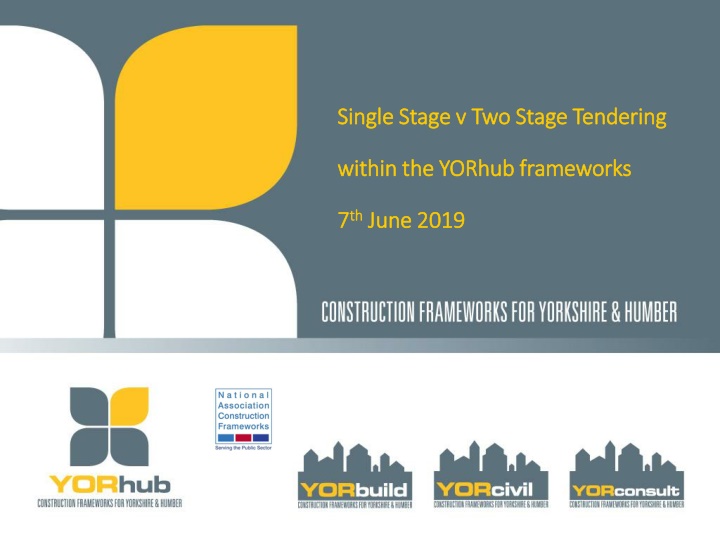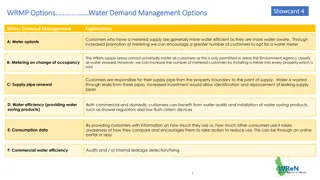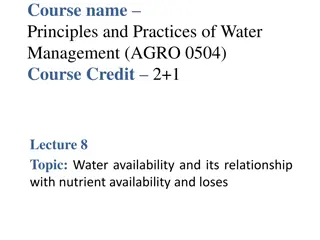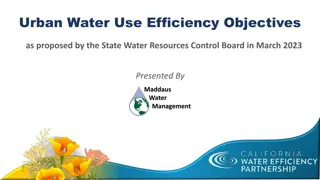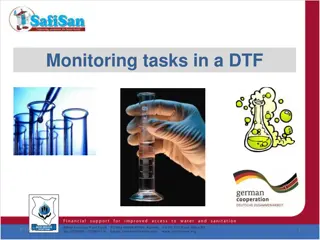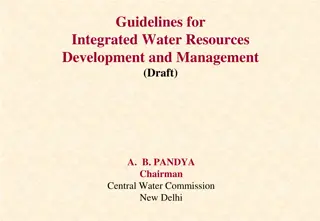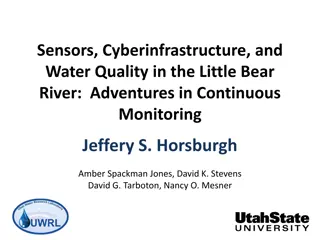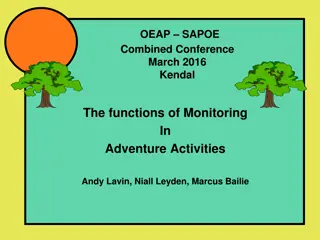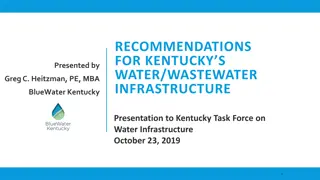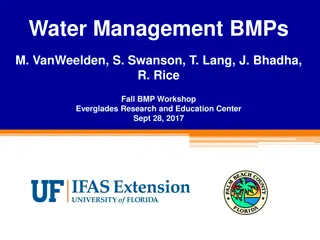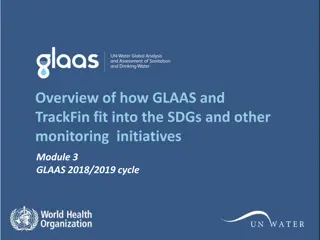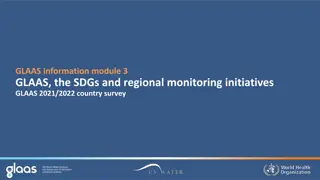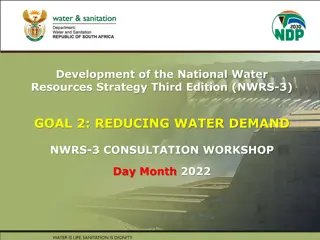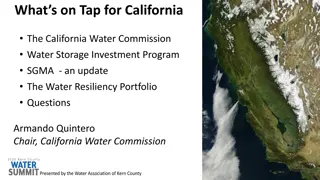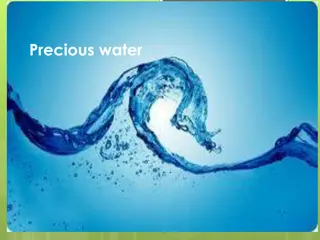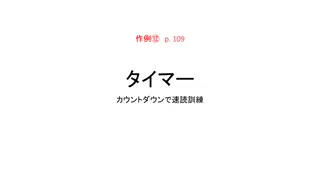Water Management System for Efficient Resource Monitoring
The Water Management System (WMS) is a computer system designed to support water resource management, emphasizing quality and sustainability. It consists of sub-systems for resource quality monitoring, sustainable water use, and geographical information display. WMS facilitates maintaining national databases, managing operational monitoring, ensuring compliance, determining trends, assessing toxicity, and modeling future scenarios, among other functions. It utilizes geographical features like rivers, water bodies, and groundwater to assess impacts, associations, and status across different management areas.
Download Presentation

Please find below an Image/Link to download the presentation.
The content on the website is provided AS IS for your information and personal use only. It may not be sold, licensed, or shared on other websites without obtaining consent from the author.If you encounter any issues during the download, it is possible that the publisher has removed the file from their server.
You are allowed to download the files provided on this website for personal or commercial use, subject to the condition that they are used lawfully. All files are the property of their respective owners.
The content on the website is provided AS IS for your information and personal use only. It may not be sold, licensed, or shared on other websites without obtaining consent from the author.
E N D
Presentation Transcript
Single Stage v Two Stage Tendering Single Stage v Two Stage Tendering within the within the YORhub YORhubframeworks frameworks 7 7th thJune 2019 June 2019
Single stage v 2 stage tendering Single stage v 2 stage tendering Fergus Aitken BSc MRICS MAPM YORbuild2 Programme Manager East Riding of Yorkshire Council Chris Bourne BSc MRICS YORbuild2 Framework Manager North Area Scarborough Borough Council
YORhub YORhub Call Call- -off Options off Options 2. Quality Only Mini Competition Two Stage 3. Price Quality Mini Competition Two Stage 4. Price Quality Mini Competition Single Stage 1. Direct Selection Rotation 5. Price Mini Competition Single Stage 6. Direct Selection - Fee Initiated Qualit y Price
Format Format Definition - what is single stage and 2 stage tendering within the YORhub frameworks How do they operate What are the pros and cons of each method Summary
Definition Definition
Single stage Framework suppliers submit competitive quotations for the award of a call off contract by means of a price only or price & quality competition. Recommended timescales: Procurement Route Traditional (Contractor builds only) D&B Single Stage Assumed RIBA stage at point of tender 4 (E) 3/4 (D/E) Up to 1m Note these recommended timescales were agreed in conjunction with YORbuild firms Baseline tender period 3-4 weeks 4-6 weeks Lead-in period 2-3 weeks 6-8 weeks Over 1m - 10m Baseline tender period 4-5 weeks 5-6 weeks Lead-in period Min 4 weeks 8 weeks Over 10m Baseline tender period 4-6 weeks 5-8 weeks Lead-in period Min 4 weeks Min 8 weeks
Two stage Stage 1 - Framework Contractors submit partial price & quality information. This information is evaluated and a preferred firm is chosen (likened to a beauty parade). Min. 2 WEEKS Min. 2 WEEKS Min. 2 WEEKS Contractors respond Client concludes evaluation Client completes stage 1 selection template plus appendices Stage 2 - A full Tender price is subsequently developed with the selected Framework Supplier and a call off contract is awarded, all going well. The timescale for this is typically 3-6 months but can be quicker or take longer.
How do they operate How do they operate
Price Price single stage single stage Normally lowest price wins (or scores highest marks if using price/ quality evaluation) Framework capped rates apply (fees, prelims, plant) Option of using adjustment model on NEC contracts Excellent tender assessment spreadsheet available on yorhub.net
Price Price 2 stage 2 stage 4 optional headings (min 2 required) Selection stage - Price Criteria Normally lowest price wins Fee percentages x Clients estimated construction cost Partial price only Prelim costs for the proposed call off project Design costs Framework rates apply (capped) Works cost criteria e.g. Bill of Quantities (BofQ), rates for works or cost plan Preferred firm then negotiates price during 2nd stage
Price Price 2 stage 2 stage contd contd Mechanisms are in place within the YORhub frameworks to ensure VFM is obtained during the 2nd stage negotiation: Minimum 3 quotes required for sub-contracted work and materials etc Business case for in-house trade pricing to demonstrate VFM Framework rates apply (capped) for Fee/OHP s, Prelims and Plant Independent cost checks Therefore all tender pricing will have been the subject of a competitive process
Quality Quality single stage single stage 6 optional headings (minimum 2 required) QUALITY CRITERIA Tender programme Outline method statement for the project Weightings can be adjusted (max 50% per heading) The proposed team The proposed Contractor s design team Excellent tender assessment spreadsheet available on yorhub.net Employment and Skills Plan & method statement Social and Economic Value
Quality Quality 2 stage 2 stage 7 optional headings (minimum 2 required) Quality Criteria The Supplier s proposed team. Weightings can be adjusted (max 50% per heading) The Supplier s resources and supply chain The notified completion date The notified estimate for the Works Potential to deliver added value Excellent tender assessment spreadsheet available on yorhub.net The Supplier s initial assessment of contract risks and proposals to mitigate these. Employment and Skills
Framework weightings Framework weightings - - flexibility flexibility Single stage 2 Stage Price no lower than 30% and no higher than 90% Price no lower than 20% and no higher than 80% Therefore anything between 30% Price/70% Quality and 90% Price/10% Quality are permissible Therefore anything between 20% Price/80% Quality and 80% Price/20% Quality are permissible 14
YORhub YORhub Process flowcharts Process flowcharts 15
Two stage mini comp Two stage mini comp - - flowchart extract flowchart extract 3 different flowcharts exist on yorhub.net site Direct selection (rotation) Single stage Two stage Hyperlinks to templates/ spreadsheets Stage 1 template useful see opposite
Pros and cons Pros and cons
Key requirements Key requirements Time +Risk +BIM Cost Quality 18
Pros Pros - - cost cost Single stage 2 Stage Competitive tension usually gives better prices Can match tendered prices and better them with positive engagement from all parties Straightforward process Prices are negotiated, giving greater flexibility Is standard industry practise and is well understood Benefits from contractor and supply chain input. Option of partnering further down the supply chain Alternative offers can be invited (but can be difficult to evaluate) Full transparency of pricing If the contractors profit is secured there should be more focus on delivering a successful project If cost planning is adopted during the negotiation there is the ability to manage budget pressures Potential to harvest VE ideas from stage 1 bidders Greater ability to influence selection of supply chain Should lead to fewer post contract changes 19
Cons Cons - - cost cost Single stage 2 Stage Messy to negotiate post tender when the budget is exceeded Contractors can get greedy clever estimators over measure rates or exploit plugged rates. Minimal input from tenderers and their supply chains may be costing the client more if the design is over specified or over designed Items where the Contractor would normally accept the risk get added to the price e.g. site security Lack of transparency of pricing If the contract is awarded on a target cost basis access to and understanding of actual costs can be difficult Race to the bottom Relies of positive engagement from all parties to work effectively needs careful team selection Lacks price certainty until tenders are returned It can be difficult to challenge the cost of in house trades (YORhub requires a business case to address this) D&B not popular with tenderers, seen as too risky 20
Pros and cons Pros and cons - - time time Single stage 2 Stage Is a quick and relatively straightforward process As the Contractor can be involved much earlier there is the potential to save time Tenderers are often given insufficient time to tender and either price in risk or gamble, resulting in higher prices or prices lower than they should be Negotiations are time consuming and can be difficult to manage and can drag on if a programme isn t developed and followed Tenders often withdraw due to unrealistic deadlines Tenderers can prioritise single stage projects, leading to delays The contract period is often dictated by the design team without input from contractors and may not be feasible or could be over generous Realistic programmes can be agreed. Some Contractors have good access to off site solutions, saving on site build time Enabling contracts are easier to arrange and can minimise time on site. 21
Pros and cons Pros and cons - - quality quality Single stage 2 Stage On a client designed projects the quality is largely dictated by the clients design team. Increasingly tenderers seem to be taking advantage of the equal approved option and proposing alternatives The 2 stage process enables joint decisions to be made on product and system selection with the potential to benefit the project On D&B projects with output specifications there is limited time to fully assess the different products or systems proposed by tenderers Similar to the above there is generaly more time to assess the products or systems. 22
Pros and cons Pros and cons - - risk risk Single stage 2 Stage The quality of tender documents* is variable and sub-standard documents expose the client to risk A collaborative process should ensure that issues with the design or spec. are identified and resolved Contractors are given minimal lead in times and this can cause problems On negotiated projects the contractor hits the ground running as they ve had time to carefully plan project delivery Should lead to fewer post contract changes Contractors can try and take advantage by transferring more risk over to the client *Note - YORhub has produced a note of what a good tender looks like, with input from YORbuild contractors) 23
BIM BIM Single stage 2 Stage It is difficult to obtain full BIM benefits on a single stage tender A 2 stage process enables the full benefits of BIM to be exploited, benefiting time, cost, quality and minimising risks 24
Summary Summary
Summary Summary Single stage 2 Stage Single stage tendering remains the preferred approach within the public sector, despite its many drawbacks Witnessing or participating in a well run negotiation where all parties are fully engaged is a delight There is still a place for single stage tendering but this is more suited to low value, low risk projects Witnessing or participating in a poorly run negotiation where parties are at odds is a missed opportunity and does this option a disservice The failure of Carillion is partly attributed to rock bottom margins and high levels of risk being accepted on public sector tenders won in competition race to the bottom . Contractors who abuse the 2 stage process by trying to maximise their return also do this option a disservice Many clients have had a negative experience of negotiated projects for the reasons mentioned above YORhub has robust processes in place to ensure that the full benefits of collaboration including value for money can be obtained BIM benefits can be fully exploited using the 2 stage approach 26
Tender procedure choice Tender procedure choice So which procedure would you choose?: So which procedure would you choose?: 1. Time which procedure is more likely to ensure the project starts on time 2. Cost which procedure will give better value 3. Quality which procedure will give me a better product 4. Risk which procedure is better at dealing with risk Both can be used on the YORbuild2 framework.
Q&A/ Close Q&A/ Close
